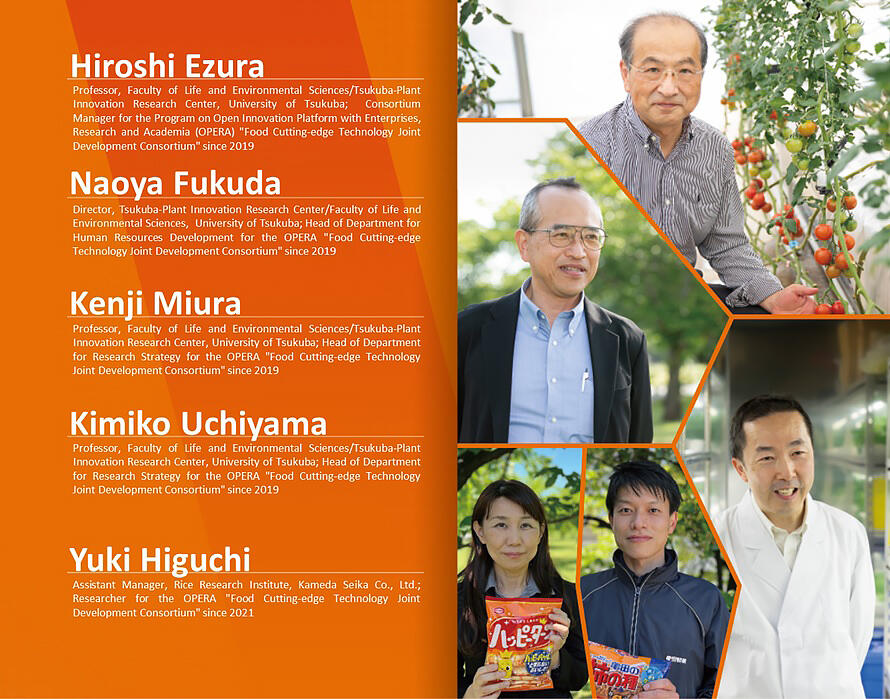
A series of meteorological disasters and changes in world affairs pose threats to food security. In addition, the social issues surrounding "food" are quite diverse, such as the increasing global population, aging agricultural workers, labor shortages, and the uneven distribution of supply and demand. Led by Professor Hiroshi Ezura of the Tsukuba-Plant Innovation Research Center at the University of Tsukuba, the OPERA "Food Cutting-edge Technology Joint Development Consortium" is tackling these issues through strong industry-academia collaboration. The project will take a variety of approaches to achieve rapid social implementation, including breeding useful crops, developing cultivation technologies, and creating next-generation industries.
Maintaining production of familiar crops ― Made possible by genome editing
Genome editing technologies are expected to be one of the technologies that will contribute to maintaining food security, which is a global issue. Genome-edited crops that have been created using these technologies are already on the market and actually available for purchase. For example, in December 2020, Japan's Ministry of Health, Labour and Welfare was given notice about the "Sicilian Rouge High GABA," a new tomato variety created by Professor Hiroshi Ezura of the Tsukuba-Plant Innovation Research Center at the University of Tsukuba, and is known as the world's first genome-edited crop to be approved for national sale.
Sicilian Rouge High GABA contains four to five times more GABA, a functional health component, than regular tomatoes, and it is attracting attention for its potential to prevent high blood pressure and to relieve stress. The seedlings were developed and sold by Sanatech Seed Co., Ltd. (based in Minato City, Tokyo), a venture company from the University of Tsukuba. The company said that they received more than 5,000 applications for free cultivation monitors before the plants went on sale. In September 2021, the company began to sell reservation orders of seeds and seedlings for home gardens, and Sicilian Rouge High GABA tomatoes produced by contract farmers, as well as processed foods made from the tomatoes, have also begun to be sold, which is a good start towards social implementation of the plants.
Also, noteworthy here is the smooth market development. The secret to realizing this is that the research and development staff themselves are involved in the commercialization of the plants, and are also involved in promoting consumer understanding towards the spread of the plants in the market. The center for this process was the OPERA "Food Cutting-edge Technology Joint Development Consortium." As of June 2022, 16 universities and companies have joined the consortium (Fig. 1) with the goal of creating and spreading new food values and of promoting industrial innovation through this process. Additionally, the consortium not only researches and develops genome editing technologies itself, but also promotes understanding of genome-edited foods (Fig. 2).
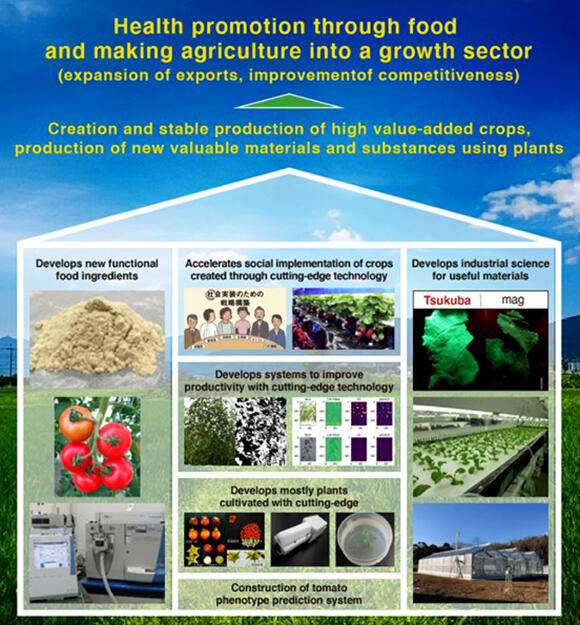
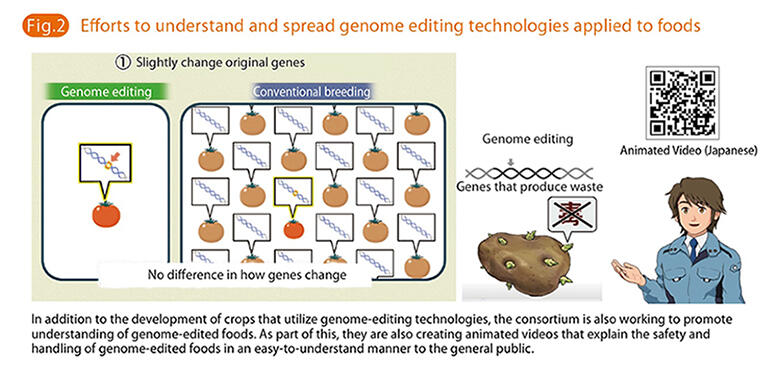
With "food" as the common keyword, the consortium is aiming to bring together industry-academia research and development and social implementation of their results through commercialization. As Consortium Manager, Professor Ezura, who is also the Chief Technology Officer at Sanatech Seed Co., Ltd., said that "We believe that the consortium will become one of the core hubs for genome-edited foods and crops, both domestically and abroad."
CRISPR-Cas9, which was announced in 2012, was the technology that led Professor Ezura to adopt genome editing technologies for improving crop varietals. Compared to conventional genome-editing technologies, CRISPR-Cas9 is a technique that enables efficient gene rewriting via simple operations, and the developers of the technique, Professor Charpentier and Professor Doudna, won the 2020 Nobel Prize in Chemistry (Fig. 3). Tomatoes, one of the varieties for which genome sequencing has been completed, were subjected to genome editing via CRISPR-Cas9 to target activation of the enzymes involved in the biosynthesis of GABA. In doing so, high-GABA had an expression of more than 80% with a high success rate, and it can be applied to any tomato varieties.
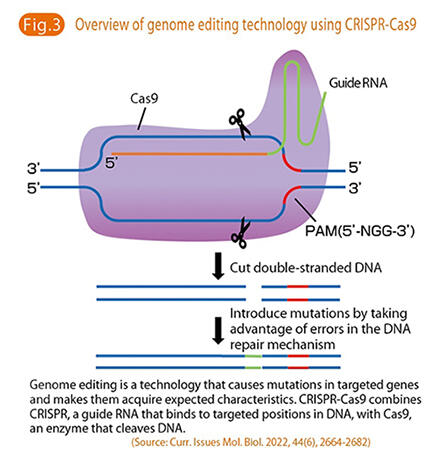
The strength of genome editing is that it allows pinpoint improvements without introducing other external genes. Conventional breeding requires 10 to 20 years to wait for desired mutations to occur, but now it is possible to achieve in as little as two years. According to Professor Ezura, "The crops that we are accustomed to eating may not always be available in the future. There is a possibility that they will become susceptible to disease and that it may not be possible to produce them. In such cases, genome editing technologies can pinpoint the problem and correct it to help maintain production. This technology will become even more useful in the future." Currently, they are also focusing on creating long-shelf life varieties and parthenocarpic varieties, which can bear fruit without pollination.
Understanding plant conditions via image analysis ― towards greenhouses managed by robots
In addition to improving crop varieties, the consortium is also working on a wide range of other themes. One such theme is research and development of labor-saving production control methods using greenhouse environmental information and image analysis technologies. As Japan continues on its path towards a super-aged society, securing a labor source for food production will be an issue. Therefore, it is essential to establish new production systems that incorporate cutting-edge technologies. In order to manage the growth of crops, it is necessary to determine the current condition of the plants, but only highly experienced farmers can make accurate visual evaluations. The challenge is to create a system that allows many farmers to manage their crops in the same way as experienced farmers, and to improve both quality and yield.
Naoya Fukuda, Director of the Tsukuba-Plant Innovation Research Center at the University of Tsukuba, said, "We are researching technology that analyzes plant growth numerically, rather than via human senses, and then manages the plants based on this analysis." This approach is being verified for horticultural crops that require strict management and are grown in greenhouses (Fig. 4).
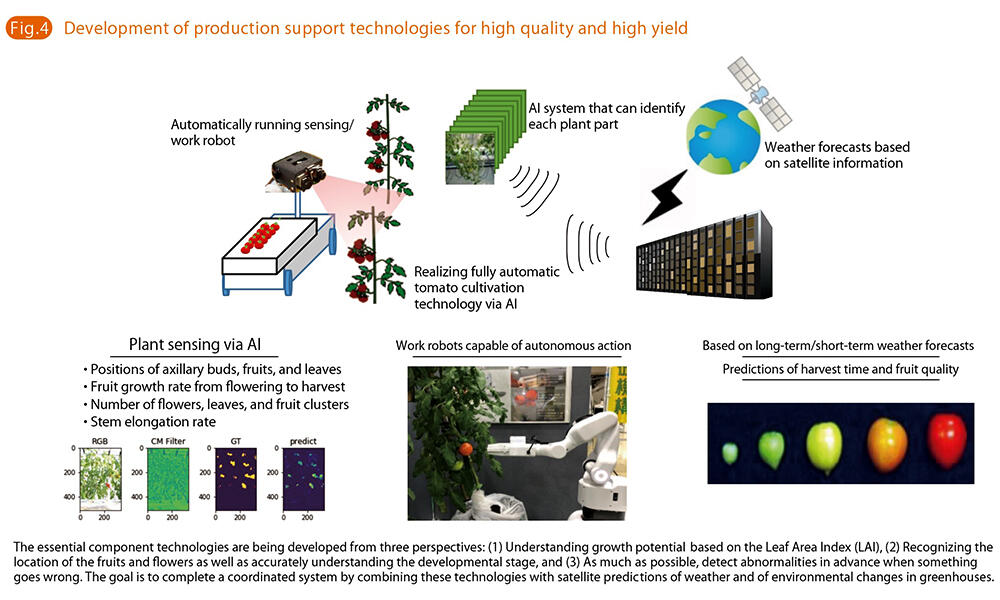
According to Director Fukuda, "By quantifying the conditions in the greenhouses and the conditions of the plants and then applying mathematical models to them, we can predict their next growth. From there, we can link this to management that improves productivity and quality." The Center's farm is lined with five green houses that reproduce the temperature and humidity of the various regions in Japan. In these greenhouses, images and sensors are used to acquire data on plant growth speeds and on nutrient utilization rates. Using these as basic data, the Center aims to establish an AI for automatic analysis and evaluation. In 2021, as one of the essential component technologies for unmanned greenhouse management, a method was established to derive the LAI (Leaf Area Index) from still images of plants and then use it in production management (see Fig. 5). LAI is a plant management index that shows how well a plant's leaves photosynthesize and produce anabolic products such as starches. Productivity does not improve if the LAI is too high or too low. The image analysis method that was developed accurately determines this from still images of plants, and a patent has been applied for it.
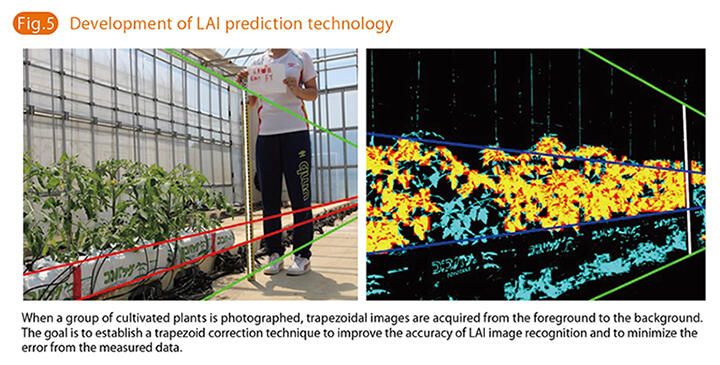
Director Fukuda estimates that, "It will probably be more than 10 years before we have completely unmanned greenhouses." The consortium will continue to develop the essential component technologies aiming for practical application in stages. In April 2022, Aicss inc. (Tsukuba City, Ibaraki Prefecture), a venture company from the University of Tsukuba, was also launched with a view towards social development. The company will put the established essential component technologies into practical use as applications, starting with those that are ready, and then send them out into the world. First, they will develop a service that allows users to obtain, from a single smartphone, useful information on cultivation management. The service does not require large investments, such as the construction of a new greenhouse, and it is expected that it will be a steppingstone to facilitate the smooth spread of the technology by reducing the technical and economic burdens of introduction.
Director Fukuda expressed confidence in it, saying "We were able to demonstrate the feasibility of a technology that uses artificial intelligence and image analysis to understand the crops' physiological condition, which in the past could only be perceived by well experienced farmers using their senses." In the future, Director Fukuda hopes to combine and integrate these applications and link them with robots. The goal is to realize greenhouses where robots perform automated tasks, such as spraying chemicals if there is an abnormality and picking fruit as if it was being done by a human hand.
Utilizing proteins made by plants: Contributing to the medical and health fields
The consortium is also conducting research on having plants produce useful substances. The corresponding person for this project is Professor Kenji Miura of the Tsukuba-Plant Innovation Research Center at the University of Tsukuba. Genes that produce a target protein are introduced into a model plant, Nicotiana benthamiana (a relative of the tobacco plant), using agrobacterium. A virus-derived self-replication mechanism is activated in the plant cells, and then the protein is produced and accumulated (Figures 6 and 7). According to Professor Miura, "We are aiming to contribute to the medical field by producing proteins that are related to cytokines for cell proliferation."
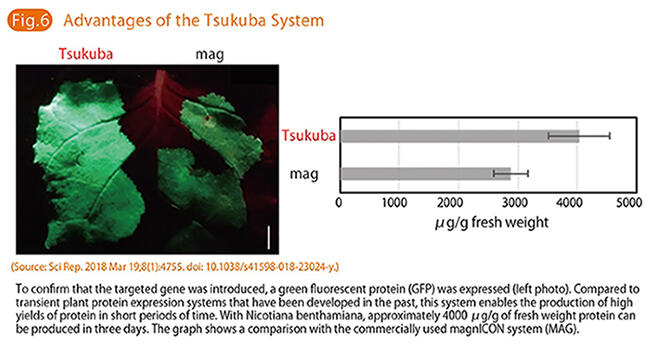
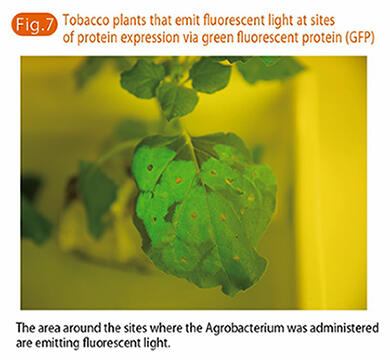
While the production of useful proteins by using plants is inexpensive, it has the problem of amounts of low expression for the introduced genes. Professor Miura and his colleagues have developed a unique method called the "Tsukuba System" that has improved vectors and has succeeded in expressing high amounts of protein in plant cells (Fig. 8). Professor Miura explained that "Tobacco mosaic virus is usually used as the viral vector, but we used a geminivirus. This means that it can be applied to plants other than tobacco, such as tomatoes, melons, and lettuce." Using the Tsukuba System as a base technology, they are aiming for establishment of protein production system in plants and are also working to create next-generation industries.
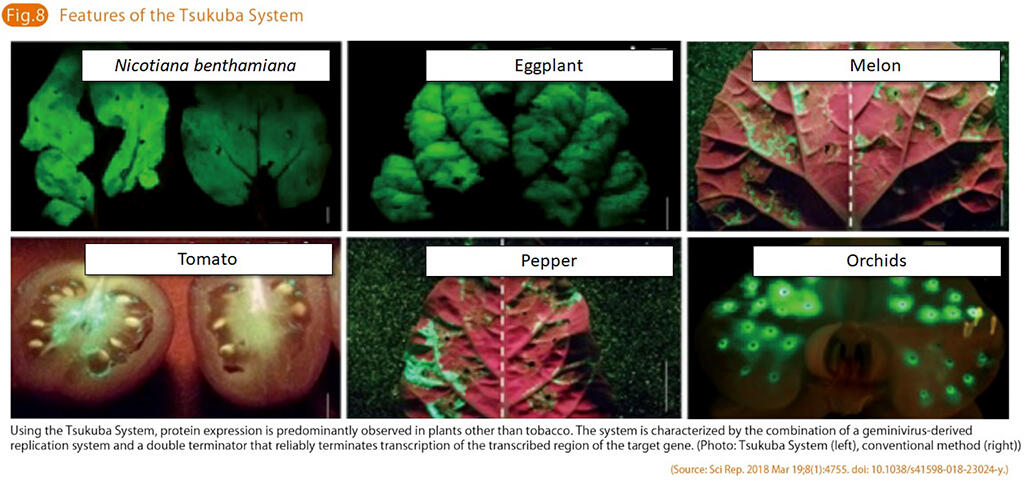
In contrast to this, research is also being conducted to maximize the effective use of proteins that are originally produced by plants (Fig. 9). Kimiko Uchiyama, manager at the Rice Research Institute in Kameda Seika, said that "As a company that makes Japanese senbei rice crackers, we focus on the useful components of rice as a raw material. Although rice only contains six to seven percent protein, it has a long history of contributing to the health of the Japanese people." By using a variety of digestive enzymes to break down the proteins contained in rice, a variety of broken-down peptides with various functions are produced.
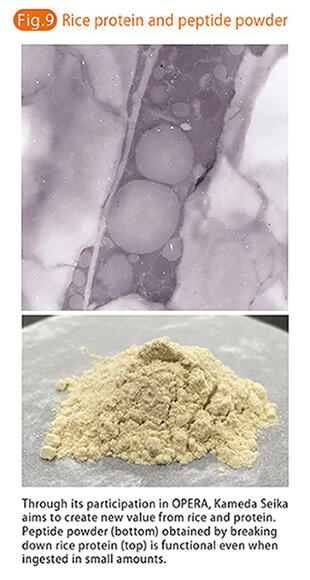
The functions of each peptide are being analyzed in detail, and after conducting clinical trials the aim is to commercialize the peptides as functional health foods. According to Yuki Higuchi, assistant manager at the Rice Research Institute in Kameda Seika, "We are conducting research and development focused on raising bone metabolism to strengthen bones, on preventing kidney disorders, and on anti-obesity effects." For many years Kameda Seika has been producing low-protein rice for patients with chronic kidney disease. "We want to make effective use of the useful protein that is removed from the rice." This is the strong desire that is the driving force behind their research. Technologies that maximize the use of resources will be an important perspective for sustainable food production.
A three-legged race run by Industry and Academia: The future of healthy and delicious food
Professor Ezura also talked about the strengths of the OPERA "Food Cutting-edge Technology Joint Development Consortium," which seeks to open up the future of food via a variety of such approaches. "The consortium has a system in which researchers working on a variety of themes and companies directly involved in commercialization participate from the development stage, so that they can be immediately deployed into society with immediate effect. The participation of companies that sell products to consumers and directly listen to their feedback is reassuring to the researchers. We hope to take on new challenges together."
As for the relationship between food and new technologies, Director Fukuda expressed his view that, "Today, consumers have a wide range of demands and requests, and, instead of just feeding them until they are full, we need to achieve sustainable production while improving quality of life (QOL) of the people who are eating. The introduction of new technologies and policies to support this will become indispensable."
The consortium will continue to take on the challenge of strong industry-academia collaboration so that the fruits of its research and development will take root and bear fruit in society. Professor Ezura concluded, "There are only three years left in the consortium. With this last breath I think we will be able to come up with a lot of new products," he concluded, exuding his enthusiasm. Going forward, attention must remain focused on these new technologies that will help realize the future of food, where people aim to eat well and be healthy.
(Text: Mayumi Nishioka, Photo: Hideki Ishihara)




